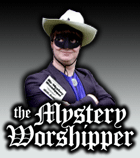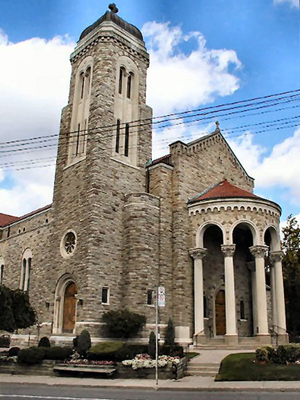| |
 |
 |
 |
| Comment on this report, or find other reports. |
 |
| Our Mystery Worshippers are volunteers who warm church pews for us around the world. If you'd like to become a Mystery Worshipper, start here. |
 |
| Find out how to reproduce this report in your church magazine or website. |
|
|
| 1632: Our Lady of Perpetual Help, Toronto, Ontario, Canada |
 |
 |
 |
Mystery Worshipper:
Religulous.
The church:
Our Lady
of Perpetual Help, Toronto, Ontario, Canada.
Denomination:
Roman Catholic, Archdiocese
of Toronto.
The building:
Built in the early 20th century, OLPH (as it is frequently called)
is an attractive neo-Romanesque stone building, with rounded
windows and arches and a red metal roof reminiscent of Italian
churches. There is a semi-circular portico with six stone pillars
at the front entrance, and a square tower with a curious squat,
curved pyramidal roof. Inside, the church is beautiful. The
walls are sky blue, the barrel ceiling white. The congregation
sits in pews on either side of a central aisle with side aisles.
There is a choir gallery and organ in the back, two transept
chapels (one for the Blessed Sacrament, the other a baptistery).
The altar, which has a large brown marble front with a bold
symmetrical white pattern, is placed at the front of a half-dome
apse supported by six massive pillars with gilded Corinthian
capitals. Behind the apse is an ambulatory, curtained off with
drapes in the appropriate liturgical colour. The excellent artwork
is mostly 20th century, except for a large Byzantine icon medallion
of Our Lady of Perpetual Help which hangs from the front of
the apse ceiling. The whole effect is tasteful and restrained.
The nave lights, however, are bizarrely incongruous. They looked
to me like flying saucers from the 50s; my friend thought they
were more like hanging truck tire rims.
The church:
This may be one of Toronto's most prosperous congregations.
Their many ministries and devotional activities are well documented
on their website. Noteworthy is a series of "luncheon talks"
on a variety of religious topics hosted by one of the parish
priests following the weekday mass at noon. They also sponsor
Living with Separation and Divorce, a group counseling session;
numerous musical events; and a canned food drive. The parish
supports the St Vincent de Paul Society. There are also lay
pastoral visitors. Sunday masses begin with an anticipated mass
on Saturdays at 5.00pm, and on Sundays at 9.30am (children’s
liturgy), 11.00am and 4.00pm. There is a mass each weekday at
12.10pm preceded by the Rosary at 11.50am. On holidays, mass
is celebrated at 9.30am.
The neighbourhood:
OLPH is near the intersection of two very busy streets in midtown
Toronto, at the northeast corner of Rosedale, one of Toronto's
toniest neighbourhoods. It is just south of the 200 acre Mount
Pleasant Cemetery.
The cast:
The Revd James Hannah, pastor, presided. The homily was given
by the Revd Daniel Donovan, a retired theology professor who
regularly assists at weekend masses.
The date & time:
October 19, 2008, 11.00am.
What was the name of the service?
Sunday Mass.
How full was the building?
Five minutes before the service I counted 50 people, including
the choir, in a building that seats several hundred. When I
returned from communion, I realized that another 50 to 75 people
had come in after my initial count. Even so, the church was
still less than half full. Perhaps the 9.30 family mass draws
a larger crowd. I noticed people from all age groups, and most
were generally well dresed. Most men wore sports jackets and
ties (unusual for Roman Catholics in Toronto), though I did
see several pairs of jeans as people walked up for communion.
There was a larger proportion of Western European types than
usual in my experience of Catholic churches in Toronto, although
there were a few people of Asian and South Asian background
as well.
Did anyone welcome you
personally?
We arrived about 15 minutes early, and there was no one to welcome
us. Two gentlemen in the narthex were looking for something
in a cupboard. I asked one of them where I could find a bathroom,
and was directed to a small washroom at the west end of the
narthex. I'll have more to say in a moment about this and its
sister washroom at the east end.
Was your pew comfortable?
Though I have recently had surgery, I found the unpadded wooden
pew quite comfortable.
How would you describe the pre-service
atmosphere?
As we entered the church, the choir were rehearsing a beautiful
anthem in the gallery, and a few people were scattered around
the church in silence.
What were the exact opening words of the
service?
The cantor said, "Good morning. Today we are celebrating the
29th Sunday of ordinary time. Please join in singing our first
hymn, 'All who hunger,' number 589 in the red hymn book."
What books did the congregation use during the
service?
The second edition of the hymnal Gather Comprehensive
and The Catholic Book of Worship II.
What musical instruments were played?
The gallery pipe organ (briskly, as will be seen).

Did anything distract
you?
In the west washroom, I was surprised to find a stained glass
window depicting Eve offering Adam a plump apple (the fruit
was actually a sizable chunk of red glass). Under the image
was the inscription "TEMPTATION." It did give me pause to wonder
why that particular image had been chosen for a narthex washroom.
After mass, I was curious to see the window in the east washroom.
There, depicted in stained glass, were Popes Leo XIII, Pius
X and Pius XI with the inscription "Rerum Novarum. Gloria."
I assume the text is a reference to the encyclical of Leo XIII,
promulgated May 15, 1891, remarkable for its vivid depiction
of the plight of the 19th century urban poor and for its condemnation
of unrestricted capitalism. Along with Leo, Pius X and Pius
XI were also great advocates of social justice, among other
things. But why in a washroom? At least the window fit the theme
of the homily.
Was the worship stiff-upper-lip,
happy clappy, or what?
The worship was formal without being stuffy – a relatively
liberal Catholic mass with simple ceremonial, excellent preaching,
and a good choice of hymns. The congregation seems to have grasped
well the liturgical advances of Vatican II. It therefore struck
me as somewhat inappropriate to see the presider sitting alone,
high above everyone else, while the preacher and three young
servers sat far away at the side of the apse, with the cantor
opposite.
Exactly how long was the
sermon?
10 minutes.
On a scale of 1-10, how good was the preacher?
9 – Father Donovan was very clear and extraordinarily articulate. While admitting he was no expert on financial matters, he spoke with the authority of a teacher and the humility of a good pastor.
In a nutshell, what was the sermon
about?
The homily was about Jesus saying, "Give to the emperor what
is the emperor's and give to God what is God's." In light of
the recent world financial crisis, we should consider our priorities.
What's really important, ultimately, is not what we have but
who we are – and we are God's.
Which part of the service was like being in
heaven?
The sermon was wonderfully expressed and thought-provoking.
I have been to many Roman Catholic churches in Toronto and the
preaching has been almost universally abysmal, poorly prepared
and even more poorly presented. So Father Donovan's homily was
truly extraordinary. Also, the building itself is really lovely
in its simple, uncluttered beauty.
And which part was like
being in... er... the other place?
I was sad to see the church so empty. I live in one of Toronto's
lowest income suburbs, and the Catholic church at the end of
my street (which seats about the same number as OLPH) is packed
at three masses every Sunday. And I found the organ playing
increasingly annoying. The hymns began at a good clip, but always
got progressively faster. Even the cantor (an excellent baritone)
had difficulty keeping up at times. By the end of the mass I
was convinced that the organist was in a hurry to get somewhere
else! As well, no one in the congregation seemed to be singing
at all. The only voices I could hear were from the cantor, who
was miked, and the choir in the back gallery. Also, all but
one hymn ended abruptly, before we had finished all the verses.
What happened when you
hung around after the service looking lost?
A very few people briefly stood in small groups on the front
lawn, but for the most part the congregation left immediately.
There was no coffee.
How would you describe the after-service
coffee?
Sorely missed!
How would you feel about making this church your regular (where 10 = ecstatic, 0 = terminal)?
7 – As a fourth generation Canadian of British descent,
I found the mass at OLPH unusually comfortable. Toronto is one
of the most culturally diverse cities in the world, and yet
it is sometimes hard for the ear accustomed to hearing North
American or British English to understand English as spoken
elsewhere in the world, even if as a native tongue. OLPH is
among the few Roman Catholic churches I've visited where the
clergy speak English with a North American accent. I'm not quite
sure why this is the case – perhaps Westerners are not answering
the call to vocations as they once did.
Did the service make you feel glad to be a
Christian?
It did indeed. I was very happy to share in the celebration of the eucharist.
What one thing will you remember about all this in seven days' time?
The one thing I will remember in seven days time are the TEMPTATION
and Rerum Novarum windows in the washrooms. |
|
|
 |
 |
 |
| We rely on voluntary donations to stay online. If you're a regular visitor to Ship of Fools, please consider supporting us. |
 |
 |
 |
| The Mystery Pilgrim |
 |
| One of our most seasoned reporters makes the Camino pilgrimage to Santiago de Compostela in Spain. Read here. |
 |
 |
 |
| London churches |
 |
| Read reports from 70 London churches, visited by a small army of Mystery Worshippers on one single Sunday. Read here. |
| |
|
|
|
|


